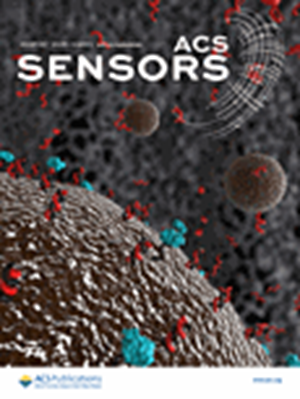通过敏感的催化发夹自组装反应研究DNA甲基化修饰的8-17 DNAzyme功能。
IF 8.2
1区 化学
Q1 CHEMISTRY, ANALYTICAL
引用次数: 0
摘要
8-17 DNAzyme是一种众所周知的多功能核酸工具,可以实现特定的切割功能,因此研究8-17 DNAzyme的功能具有重要意义。对DNAzyme进行常规表观遗传修饰可为其催化性能的研究开辟新的途径。本文在8-17 DNAzyme的中心催化核心和主干序列中引入了最丰富和表征最好的修饰5-甲基胞嘧啶(5mC)和n6 -甲基腺苷(m6A),以评价其裂解活性。经过修饰的8-17 DNAzymes可以识别和切割含有5‘- ag -3’基序的单链DNA (ssDNA)底物,由于它们的切割效率不同,产生大量的短ssDNA,并留下不同数量的未降解ssDNA。同时,利用未降解的ssDNA作为新的底物,引发催化发夹自组装(CHA)反应。得益于CHA反应的简单和敏感,甲基化诱导的裂解活性波动可以直接放大和检测。此外,双加氧酶10 - 11易位蛋白2 (Tet 2)为通过去甲基化过程探索甲基化修饰DNAzymes的可逆性提供了可能性。在本研究中,我们发现环状催化核心的5mC和m6A修饰都可能对8-17 DNAzyme的催化活性产生显著的抑制作用。然而,当茎区标记5mC时,观察到的变化很小。此外,碱性条件(pH = 9.5)使DNAzyme-19-5mC的裂解活性部分恢复(约52.9%)。更令人惊讶的是,利用这些8-17 DNAzymes研究了非小细胞肺癌(A549)细胞和人宫颈癌(HeLa)细胞中miRNA-21水平的调节,发现细胞内miRNA-21含量的降低与被试细胞的死亡呈正相关。该研究有望推动表观遗传学研究,极大地拓展DNAzymes的生物传感应用。本文章由计算机程序翻译,如有差异,请以英文原文为准。
Investigation of the DNA Methylation-Modified 8-17 DNAzyme Functions via Sensitive Catalytic Hairpin Self-Assembly Reaction.
8-17 DNAzyme is a well-known versatile nucleic acid tool for achieving a specific cleavage function, and thus, investigation of 8-17 DNAzyme functions can prove to be of great significance. The conventional epigenetic modification on DNAzyme may pave a new way for the study of catalytic properties. Herein, the most abundant and best characterized modifications 5-methylcytosine (5mC) and N6-methyladenosine (m6A) are introduced into the central catalytic core and stem sequence of 8-17 DNAzyme to evaluate the cleavage activity. The modified 8-17 DNAzymes are arranged to recognize and cleave single-stranded DNA (ssDNA) substrates that contain a 5'-rAG-3' motif, producing large numbers of short ssDNA and leaving different amounts of undegraded ssDNA because of their disparate excision efficiency. Meanwhile, the undegraded ssDNA is used as new substrates for triggering the catalytic hairpin self-assembly (CHA) reaction. Benefiting from the facile and sensitive CHA reaction, the methylation-induced fluctuations of cleavage activity can be directly amplified and detected. Moreover, dioxygenase ten-eleven translocation protein 2 (Tet 2) offers a possibility for exploring the reversibility of methylation-modified DNAzymes through a demethylation process. In this study, we found that both 5mC and m6A modifications in the circular catalytic core might lead to a significant inhibition effect on the catalytic activity of 8-17 DNAzyme. However, little variation was observed when the stem region was labeled with 5mC. Additionally, the alkaline condition (pH = 9.5) enabled the partial recovery of cleavage activity for DNAzyme-19-5mC (∼52.9%). More impressively, these 8-17 DNAzymes were employed to study the regulation of miRNA-21 level in nonsmall cell lung cancer (A549) cells and human cervical cancer (HeLa) cells, revealing that the decrease of intracellular miRNA-21 content showed positive correlation with the death of tested cells. This study would hopefully advance the epigenetics research and dramatically expand the biosensing application of DNAzymes.
求助全文
通过发布文献求助,成功后即可免费获取论文全文。
去求助
来源期刊

ACS Sensors
Chemical Engineering-Bioengineering
CiteScore
14.50
自引率
3.40%
发文量
372
期刊介绍:
ACS Sensors is a peer-reviewed research journal that focuses on the dissemination of new and original knowledge in the field of sensor science, particularly those that selectively sense chemical or biological species or processes. The journal covers a broad range of topics, including but not limited to biosensors, chemical sensors, gas sensors, intracellular sensors, single molecule sensors, cell chips, and microfluidic devices. It aims to publish articles that address conceptual advances in sensing technology applicable to various types of analytes or application papers that report on the use of existing sensing concepts in new ways or for new analytes.
 求助内容:
求助内容: 应助结果提醒方式:
应助结果提醒方式:


